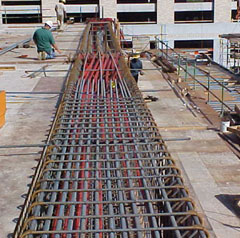
There is more to design than calculating the forces in the structural members and proportioning the sections. Good structural analysis and design must be complemented with appropriate reinforcement detailing to insure that the structure as a whole behaves as it is modeled by the designer. On the other hand, a poorly detailed structure may suffer from unsightly cracks, excessive deflection or even collapse. Good details and bar arrangements should be practical, buildable, cost-effective, and suitable for their intended use.
Reinforcement is provided mainly to resist internal tensile forces calculated from analysis. Also, reinforcement is provided in compression zones to increase the compression capacity, enhance ductility, reduce long term deflections, or increase the flexural capacity for beams. The ACI 318
Building Code provides provisions for reinforcement detailing to prevent excessive crack width under service conditions.
In addition, reinforcement is required to prevent excessive cracking resulting from shrinkage or temperature changes in restrained structural elements. Lateral reinforcement (stirrups, ties and hoops) are used to provide resistance to principal tensile stresses resulting from shear. Lateral reinforcement in highly stressed areas of compression zones of columns beams and joint provides confinement. This is important especially in structures located in high seismic risk zones.
It is important to provide the adequate area of reinforcement required to resist internal tensile or compression forces required to attain the design section strength. The provided area of reinforcement is not fully effective unless it is fully developed. The fundamental requirement for development of reinforcing bars is that a reinforcing bar must be embedded in concrete a sufficient distance on each side of the critical section to develop the peak tension or compression force in the bar at the section. The reinforcement may be developed by embedment length, hooks, mechanical anchorage devices, headed deformed reinforcement, or a combination of these methods.
In addition to providing the sufficient areas of reinforcement and the required development lengths, good detailing should be done considering the overall structural integrity. The overall ability of a reinforced concrete structure to withstand abnormal loads resulting from unforeseen events, which cannot be considered in design, can be enhanced substantially by providing relatively minor changes in the detailing of the reinforcement. The American Concrete Institute’s Building Code Requirements for Structural Concrete (ACI 318-08) Section 7.13 (and others) set forth provisions for structural integrity reinforcement intended to enhance continuity, improve the redundancy and ductility of structures. This is achieved by providing, as a minimum, some continuity reinforcement or tie between horizontal framing members.
Publications
 Seismic Detailing of Concrete Buildings,
Seismic Detailing of Concrete Buildings, SP382
This publication contains a comprehensive summary of the seismic detailing requirements contained in Building Code Requirements for Structural Concrete (318-05) and Commentary (318R-05), which is adopted by reference in the 2006 International Building Code. A supplemental CD is included with reinforcement details for beams, columns, two-way slabs, walls and foundations.
 PCA Notes on ACI 318-08 Building Code Requirements for Structural Concrete with Design Applications, EB708
PCA Notes on ACI 318-08 Building Code Requirements for Structural Concrete with Design Applications, EB708
The tenth edition of this classic PCA resource has been updated to reflect code changes introduced in the latest version of Building Code Requirements for Structural Concrete, ACI 318-08. These notes will help users apply code provisions related to the design and construction of concrete structures. Each chapter of the manual starts with a description of the latest code changes. Emphasis is placed on “how-to-use” the code. Numerous design examples illustrate application of the code provisions.